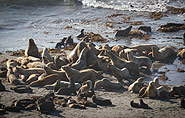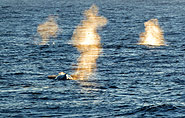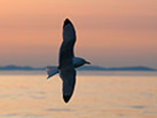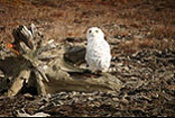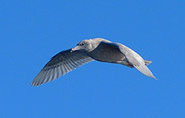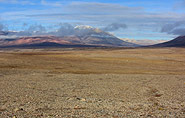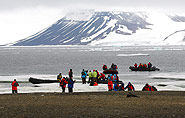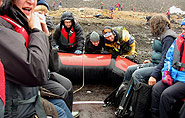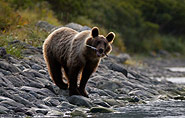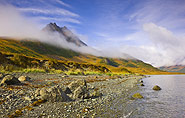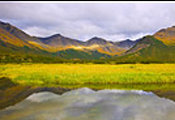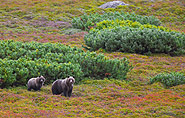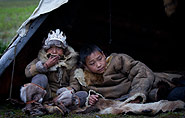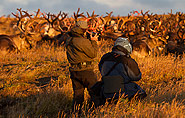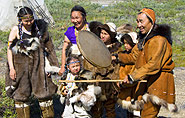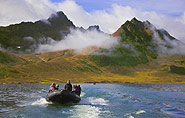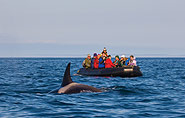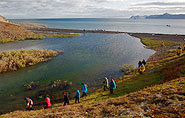Chukotka - Spectacular journey to the coasts of the Koryaks
ITINERARY
Day 1 - Flight to Anadyr
Day 2 - Anadyr
All expedition members will arrive in Anadyr; depending on your time of arrival you may have the opportunity to explore Anadyr, the administrative centre of the Chukotka region, before getting to know your fellow voyagers and crew on board the
Spirit of Enderby. There will be introductory lectures, an introduction to the staff and ship and a series of compulsory briefings and drills.
Day 3 - Egvekinot
There is more to this small town on the shores of Kresta Bay than first meets the eye. It was built by Gulag prisoners in 1946 as a port to supply the Lul’tin mining complex some 200 km inland, the prisoners also constructed the road to the mine. Today the Lul’tin mining complex is closed but the town and Port of Egvekinot is the terminus for a new road through to Pevek and its associated gold mines. The town has an excellent museum which we plan to visit. Egvekinot is only a few miles south of the Arctic Circle and today we will travel by Ural (a 6WD ‘go anywhere’ Russian truck) to the point where the Arctic Circle cross’s the road to Lul’tin and then some distance beyond so that you can see and experience the tundra habitat which dominates so much of Chukotka.
There is more to this small town on the shores of Kresta Bay than first meets the eye. It was built by Gulag prisoners in 1946 as a port to supply the Lul’tin mining complex some 200 km inland, the prisoners also constructed the road to the mine. Today the Lul’tin mining complex is closed but the town and Port of Egvekinot is the terminus for a new road through to Pevek and its associated gold mines. The town has an excellent museum which we plan to visit. Egvekinot is only a few miles south of the Arctic Circle and today we will travel by Ural (a 6WD ‘go anywhere’ Russian truck) to the point where the Arctic Circle cross’s the road to Lul’tin and then some distance beyond so that you can see and experience the tundra habitat which dominates so much of Chukotka.
Day 4 Bukhta Gavriila
This coastline is rich in marine mammals and one creature we will be looking for, in particular, is the walrus. The animals do regularly move between locations, so finding them is always very much a matter of luck, although we have had success here in the past. In the afternoon we hope to visit a well known walrus haul out lying between Meinypil’gyno and Cape Navarin.
We also plan a landing in Bukhta Gavriila.
Cape Navarin marks the place where the land bridge to North America began when sea levels were much lower. Because of strong tides around the cape there is an abundance of food and it is not uncommon to see large numbers of seabirds and good numbers of Gray Whales which often congregate here too
This coastline is rich in marine mammals and one creature we will be looking for, in particular, is the walrus. The animals do regularly move between locations, so finding them is always very much a matter of luck, although we have had success here in the past. In the afternoon we hope to visit a well known walrus haul out lying between Meinypil’gyno and Cape Navarin.
We also plan a landing in Bukhta Gavriila.
Cape Navarin marks the place where the land bridge to North America began when sea levels were much lower. Because of strong tides around the cape there is an abundance of food and it is not uncommon to see large numbers of seabirds and good numbers of Gray Whales which often congregate here too
Day 5 Pika River and Meinypil’gyno
We start the day with a visit to the delta of Pika River – a well known walrus haul out and one of the few places in the southern part of the range that still get thousands of animals coming to rest on the beach. Later in the day, we visit Meinypil’gyno, a small settlement located on a 40km long shingle spit. It is a traditional village although renovated under the recent Chukotka government. But the spirit is still alive and the village ensemble will perform for us some of their traditional dances, a chance to enjoy real Chukchi hospitality.
Meinypil’gyno is also an important breeding spot for many species of migratory birds, including Red Knot and critically endangered Spoon-billed Sandpiper. Even though the breeding season will be over by September, we have a chance of getting migrants on their way south and see the location where the research team is working hard to save the Spoon-billed Sandpiper
.
We start the day with a visit to the delta of Pika River – a well known walrus haul out and one of the few places in the southern part of the range that still get thousands of animals coming to rest on the beach. Later in the day, we visit Meinypil’gyno, a small settlement located on a 40km long shingle spit. It is a traditional village although renovated under the recent Chukotka government. But the spirit is still alive and the village ensemble will perform for us some of their traditional dances, a chance to enjoy real Chukchi hospitality.
Meinypil’gyno is also an important breeding spot for many species of migratory birds, including Red Knot and critically endangered Spoon-billed Sandpiper. Even though the breeding season will be over by September, we have a chance of getting migrants on their way south and see the location where the research team is working hard to save the Spoon-billed Sandpiper
.
Day 6 Bukhta Natalii
Along the Koryak Coast there are many beautiful fiords (bukhtas or bays) and none are more beautiful than Bukhta Natalii. This fiord has two smaller fiords that drain into it from the south; called Bukhta Pavla and Bukhta Petra (named after St Peter and St Paul by Commander Vitus Bering).
We will cruise to the head of Bukhta Pavla and make a landing. This will be a great opportunity to explore the inland as we hike from one bay to be picked up by the ship in another. The magnificent mountain landscapes and tundra vegetation will surround us, along with the possibility of sighting Snow Sheep, as they were often seen in the area. There is a historic walrus haul out on Bogoslova Island which guards the entrance to these fiords.
Along the Koryak Coast there are many beautiful fiords (bukhtas or bays) and none are more beautiful than Bukhta Natalii. This fiord has two smaller fiords that drain into it from the south; called Bukhta Pavla and Bukhta Petra (named after St Peter and St Paul by Commander Vitus Bering).
We will cruise to the head of Bukhta Pavla and make a landing. This will be a great opportunity to explore the inland as we hike from one bay to be picked up by the ship in another. The magnificent mountain landscapes and tundra vegetation will surround us, along with the possibility of sighting Snow Sheep, as they were often seen in the area. There is a historic walrus haul out on Bogoslova Island which guards the entrance to these fiords.
Day 7 Tintikun Lagoon
Much of the southern Govena Peninsula was recently made into a state reserve. There are a number of fiords included in the reserve; one of the most spectacular is Tintikun Lagoon This fiord was blocked by a large terminal moraine during the last
period of glaciation. A shallow river surrounded by jagged mountains, glaciers and forested slopes has breached the moraine, allowing access to one of the most picturesque locations found anywhere in the world.
We take the Zodiacs onto the lake and intend to make several landings with Eurasian Nutcracker, Dusky Warbler, Siberian Rubythroat and Siberian Accentor amongst the possibilities. There is also a large population of brown bears and these should be feeding in and around the river mouths that drain into the head of the lagoon.
Much of the southern Govena Peninsula was recently made into a state reserve. There are a number of fiords included in the reserve; one of the most spectacular is Tintikun Lagoon This fiord was blocked by a large terminal moraine during the last
period of glaciation. A shallow river surrounded by jagged mountains, glaciers and forested slopes has breached the moraine, allowing access to one of the most picturesque locations found anywhere in the world.
We take the Zodiacs onto the lake and intend to make several landings with Eurasian Nutcracker, Dusky Warbler, Siberian Rubythroat and Siberian Accentor amongst the possibilities. There is also a large population of brown bears and these should be feeding in and around the river mouths that drain into the head of the lagoon.
Day 8 Koryakskiy Reserve and Verhoturova Island
We will start the morning in brown bear country, an undisturbed habitat within the Koryakskiy Reserve, where we will go bear watching and Zodiac cruising along the coast. Brown bears come down to the sea coast and into the nearby hills very frequently, and the area is completely protected and rarely visited. In the afternoon we visit Verkhoturova Island, where we have a chance to climb to a seabird colony. The breeding season will be over, however, some of the birds that should still be around the colony include Tufted and Horned Puffins; Pigeon, Common and Brunnich’s Guillemots and also Parakeet and Least Auklets. Pelagic
Cormorants also occur in large numbers. On nearby rocky islets there is a regular non-breeding haul out of Steller Sea Lions.
We will start the morning in brown bear country, an undisturbed habitat within the Koryakskiy Reserve, where we will go bear watching and Zodiac cruising along the coast. Brown bears come down to the sea coast and into the nearby hills very frequently, and the area is completely protected and rarely visited. In the afternoon we visit Verkhoturova Island, where we have a chance to climb to a seabird colony. The breeding season will be over, however, some of the birds that should still be around the colony include Tufted and Horned Puffins; Pigeon, Common and Brunnich’s Guillemots and also Parakeet and Least Auklets. Pelagic
Cormorants also occur in large numbers. On nearby rocky islets there is a regular non-breeding haul out of Steller Sea Lions.
Day 9 Karaginskiy Island
A few miles to the south of Verhoturova Island is the much larger Karaginskiy Island. Here we encounter some of the first ‘forests’ of the voyage. This is a change from the tundra that we have seen, a sure sign that we are getting further south. There are a large number of Red Foxes that live on the island and many migratory birds come here to their breeding grounds and on the way south.
The autumn is the best time for the wild berries and we can marvel at the richness of the local flora, as many of them would be at their best. A proposed landing site is a patchwork of boggy tundra, ponds and shingle spits. An interesting range of waders can be found here including Pacific Golden Plover, Red-necked Stint and Red-necked Phalarope. The ponds also support a range of waterfowl and previously we have encountered Red-throated Diver, Bean Goose,
Greater Scaup and Long-tailed Duck. Potential passerines include Kamchatka Leaf-Warbler, Dusky Warbler, Bluethroat, Red-throated Pipits and Eastern Yellow Wagtail.
A few miles to the south of Verhoturova Island is the much larger Karaginskiy Island. Here we encounter some of the first ‘forests’ of the voyage. This is a change from the tundra that we have seen, a sure sign that we are getting further south. There are a large number of Red Foxes that live on the island and many migratory birds come here to their breeding grounds and on the way south.
The autumn is the best time for the wild berries and we can marvel at the richness of the local flora, as many of them would be at their best. A proposed landing site is a patchwork of boggy tundra, ponds and shingle spits. An interesting range of waders can be found here including Pacific Golden Plover, Red-necked Stint and Red-necked Phalarope. The ponds also support a range of waterfowl and previously we have encountered Red-throated Diver, Bean Goose,
Greater Scaup and Long-tailed Duck. Potential passerines include Kamchatka Leaf-Warbler, Dusky Warbler, Bluethroat, Red-throated Pipits and Eastern Yellow Wagtail.
Days 10 to 11 Commander Islands
The wildlife-rich Commander Islands were first discovered by Commander Vitus Bering when his ship was wrecked here in 1741. He perished on the island along with many of his men. The reports from those that survived led to a ‘fur rush’ and the settlement of the islands. There are two large islands (Bering and Medny) with two smaller islands Ariy Karmen and Toporkov. These islands are located at the western extremity of the Aleutian chain.
We intend to explore the islands through a combination of landings and Zodiac cruises.
We plan to stop at the village of Nikolskoye, the museum is reputedly one of the best in the Russian Far East and amongst many other items it has one of the very few preserved full-size Sea Cow skeletons.
Birding around the village is also excellent and we should find Rock Sandpiper, Mongolian Plover, Glaucous-winged Gull and Pechora Pipit, with the possibilities on subsequent landings including Rock Ptarmigan, Buff-bellied Pipit and Grey-crowned Rosy Finch.
The wildlife-rich Commander Islands were first discovered by Commander Vitus Bering when his ship was wrecked here in 1741. He perished on the island along with many of his men. The reports from those that survived led to a ‘fur rush’ and the settlement of the islands. There are two large islands (Bering and Medny) with two smaller islands Ariy Karmen and Toporkov. These islands are located at the western extremity of the Aleutian chain.
We intend to explore the islands through a combination of landings and Zodiac cruises.
We plan to stop at the village of Nikolskoye, the museum is reputedly one of the best in the Russian Far East and amongst many other items it has one of the very few preserved full-size Sea Cow skeletons.
Birding around the village is also excellent and we should find Rock Sandpiper, Mongolian Plover, Glaucous-winged Gull and Pechora Pipit, with the possibilities on subsequent landings including Rock Ptarmigan, Buff-bellied Pipit and Grey-crowned Rosy Finch.
Day 12 Olga Bay
Olga Bay is a part of the very large Kronotskiy Reserve, which also includes the world-famous Valley of the Geysers. The habitat is quite different to what we will have been experiencing before with lush Kamchatka forests coming right down to the beach line. There is a possibility we will see brown bears and other forest fauna, as well as multiple bird species that live in this habitat.
The seas around Olga Bay are frequented by large numbers of Gray Whales that are usually quite friendly to the visiting boats, if the conditions are right we will take a Zodiac whale-watching cruise.
The rising volcanoes in the background will provide a beautiful setting to explore real Kamchatka wilderness
Olga Bay is a part of the very large Kronotskiy Reserve, which also includes the world-famous Valley of the Geysers. The habitat is quite different to what we will have been experiencing before with lush Kamchatka forests coming right down to the beach line. There is a possibility we will see brown bears and other forest fauna, as well as multiple bird species that live in this habitat.
The seas around Olga Bay are frequented by large numbers of Gray Whales that are usually quite friendly to the visiting boats, if the conditions are right we will take a Zodiac whale-watching cruise.
The rising volcanoes in the background will provide a beautiful setting to explore real Kamchatka wilderness
Day 13 Zhupanova River and Bukhta Bechevinskaya
This morning we make our way along the Zhupanova River by Zodiac. This journey allows us to explore a river habitat which is
common in Kamchatka. The Kamchatka Rivers (of which there are over 1,800) are important ecosystems that support a wide variety of wildlife. They are especially important for salmon spawning – one of Kamchatka’s valuable natural resources. Steller’s Sea Eagles are known to nest in the lower reaches of the river and we are very likely to see many young of the year as well as a few adults still hanging around their nesting sites. Other birds that breed here will have finished breeding at the time of our visit but some of them should still be present; there will be waterfowl, gulls and terns, possibly including the Aleutian Tern. There is also the possibility of spotting brown bears, Red Foxes and Musk Rats.
This morning we make our way along the Zhupanova River by Zodiac. This journey allows us to explore a river habitat which is
common in Kamchatka. The Kamchatka Rivers (of which there are over 1,800) are important ecosystems that support a wide variety of wildlife. They are especially important for salmon spawning – one of Kamchatka’s valuable natural resources. Steller’s Sea Eagles are known to nest in the lower reaches of the river and we are very likely to see many young of the year as well as a few adults still hanging around their nesting sites. Other birds that breed here will have finished breeding at the time of our visit but some of them should still be present; there will be waterfowl, gulls and terns, possibly including the Aleutian Tern. There is also the possibility of spotting brown bears, Red Foxes and Musk Rats.
IIn the afternoon, depending on the permits there is a possibility of visiting Cape Shipunsky and Bechevinskaya Bay where there was a secret military submarine base during the Cold War. It was completely abandoned after the collapse of the Soviet Union, but it provides an amazing image of the face of the Cold War.
Alternatively we may cruise nearby to Krasheninnikova Island – a rocky island that has a number of seabirds nesting on it, including Spectacled Guillemot and some other Bering Sea endemics. As we spend our last night at sea, celebrate and recap your voyage highlights with fellow passengers, there will be much to remember.
Alternatively we may cruise nearby to Krasheninnikova Island – a rocky island that has a number of seabirds nesting on it, including Spectacled Guillemot and some other Bering Sea endemics. As we spend our last night at sea, celebrate and recap your voyage highlights with fellow passengers, there will be much to remember.
Day 14 Petropavlovsk-Kamchatskiy
During the night the Spirit of Enderby will enter Avacha Bay which is one of the greatest natural harbours in the world.
On the shores of Avacha Bay is Petropavlovsk-Kamchatskiy, the capital and administrative centre of the Kamchatka Region. The town was founded in the 1700s by Commander Vitus Bering during the Second Kamchatka Expedition. All through the Cold War it was home to a significant part of Russia’s Pacific Fleet which included a large submarine base. The city and region was ‘closed’ to all foreign visitors until 1992.
After breakfast you will disembark and we will provide complimentary transfers to a downtown hotel and the airport. To allow time for disembarkation procedures we do not recommend booking flights before 13:00hrs
Return Flight
During the night the Spirit of Enderby will enter Avacha Bay which is one of the greatest natural harbours in the world.
On the shores of Avacha Bay is Petropavlovsk-Kamchatskiy, the capital and administrative centre of the Kamchatka Region. The town was founded in the 1700s by Commander Vitus Bering during the Second Kamchatka Expedition. All through the Cold War it was home to a significant part of Russia’s Pacific Fleet which included a large submarine base. The city and region was ‘closed’ to all foreign visitors until 1992.
After breakfast you will disembark and we will provide complimentary transfers to a downtown hotel and the airport. To allow time for disembarkation procedures we do not recommend booking flights before 13:00hrs
Return Flight
Please note:
All itineraries are for guidance only. Programs may vary depending on local ice and weather conditions and in order to take advantage of opportunities to see wildlife. Flexibility is paramount for expedition cruises.
All itineraries are for guidance only. Programs may vary depending on local ice and weather conditions and in order to take advantage of opportunities to see wildlife. Flexibility is paramount for expedition cruises.


